INTRODUCTION
The recognition of Transboundary aquifers (TBA) as significant global water resource system in international water policy and legislation is gradually establishing. Significant international effort towards recognition of TBA as key factor in environmental and human development was initiated in year 2000, when IAH and UNESCO-IPH jointly adopted the ISARM (International Shared (Transboundary) Aquifer Resource Management) programme. The programme is designed to delineate and analyze TBA systems and to encourage riparian states to work cooperatively toward mutually beneficial and sustainable aquifer development. ISARM is providing aides to sharing nations in the management of their TBA through guidelines and recommendations prepared based on the case studies carried out internationally under the programme. (Puri & Aureli, 2005).
INTERNATIONAL EFFORTS
The first phase of the ISARM programme was dedicated to compiling global inventory of transboundary aquifers that has since been published by UNESCO-IHP. The UN General Assembly (UNGA) adopted the resolution (A/RES/63/124) on the ‘Law of Tranboundary Aquifers in December, 2008. UNGA encourages the States concerned to make appropriate bilateral or regional arrangements for the proper management of their Tranboundary aquifers. Around the turn of the century the rapidly expanding exploitation of groundwater for portal, industrial and irrigation uses in both developed and developing countries and of the resulting critical over exploitation and pollution, problems were started showing its impact. Thus the Commission formulated set of 19th draft articles on the law of transboudary aquifers to encourage the States concerned to make appropriate bilateral or regional arrangements for proper management of their transboundary aquifers, taking into account the provisions of the draft articles.
The draft articles are based on the scientific evidence provided by experts and also on ample State practices as well as almost 400 relevant treaties-general regional and bilateral. The States have shown keen interest in the draft articles as aquifers exists in almost all States and the overwhelming majority of them posses transboundary aquifers with their neighboring States.
Draft articles would establish a legal framework for a proper management of transboundary aquifers in order to achieve the objectives of equitable and reasonable utilization of natural resources, protection of the environment and international cooperation .In order to promote studies on TBA under ISARM programme initiatives were taken internationally to identify five key areas for sound management of TBA. These are scientific aspects, Legal aspects, Socio-economic issues, Institutional considerations, and Environmental protection. Studies were initiated in Africa in 2002, American continent in 2003, Balkans in 2004. The scope aims and target group identified for the managing shared aquifers are -
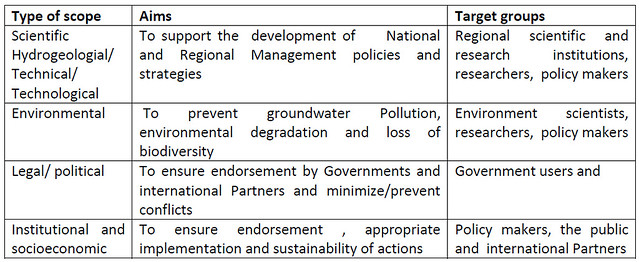 It has been estimated that in the year 2000 almost 40% of the world population, or about 2.3 billion people, were living in water basins with less than 1700m3/yr/capita, i.e under water stress. This percentage is expected to have reached 50% by the year 2025 (Revenga et al.2000) Intentional shared river catchments effect 40% of the global population and cover about 45% of the total land on Earth and about 90% in South Eastern Europe (World Bank,1987) . Some countries receive almost all their surface water from outside their international borders (e.g. about 98% for Egypt).Transboundary groundwater aquifers resources are also very important in many regions such as North Africa, Middle East and South Eastern Europe.
It has been estimated that in the year 2000 almost 40% of the world population, or about 2.3 billion people, were living in water basins with less than 1700m3/yr/capita, i.e under water stress. This percentage is expected to have reached 50% by the year 2025 (Revenga et al.2000) Intentional shared river catchments effect 40% of the global population and cover about 45% of the total land on Earth and about 90% in South Eastern Europe (World Bank,1987) . Some countries receive almost all their surface water from outside their international borders (e.g. about 98% for Egypt).Transboundary groundwater aquifers resources are also very important in many regions such as North Africa, Middle East and South Eastern Europe.As per UNESCO – IHP inventory, there are 273 known Transboundary Aquifers which include 68 in Americas, 38 in Africa, 155 in Europe,12 in Asia. The underground aquifers account for 70% water used in European Union. The Irrigation in many countries including India largely depends on ground water resources. UNESCO – IHP has brought out location map of shared aquifers as shown in the Figure-1. Some of the well known examples of Internationally Shared /Transboundary Aquifers are listed in the table-1
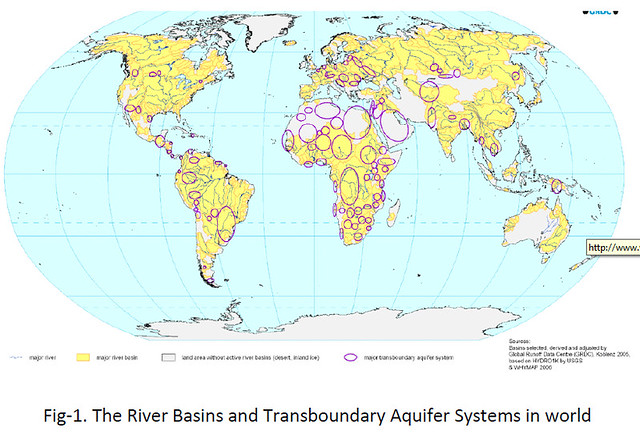
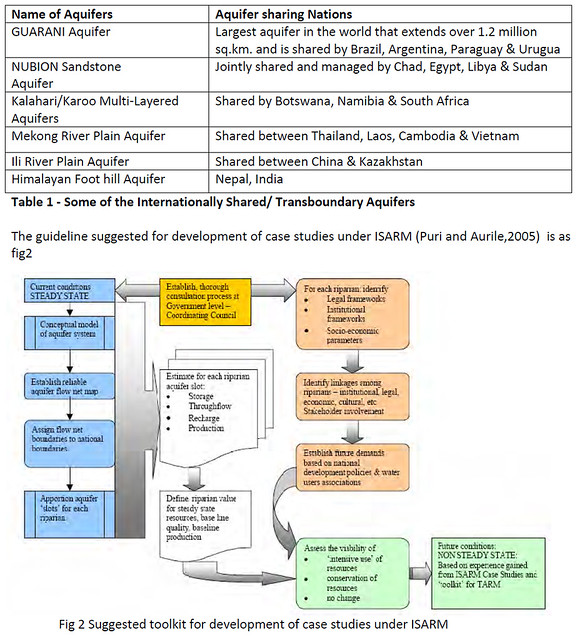
INTERNATIONAL CASE STUDIES UNDER ISARM
Under ISRAM the Economic and Social Commission for Western Asia (ESCWA) working for Arabian Plate, comprehensively ‘map’ shared groundwater system and surface water basins in Western Asia. They have identified about 25 major water basins shared between at least two riparian countries creating hydrological, social and economic interdependencies. ISARM activities in Central & Eastern Asia is a regional initiative aimed at promoting the sustainable use of transboundary aquifers (TBA) in Asia by promoting awareness of transboundary aquifers as vital natural resources, especially among the policymakers. It also enhances international collaboration when it comes to sustainable management of these shared aquifers. Twelve Transboundary Aquifers were identified in Central South and East-Asia.
Eight additional Transboundary Aquifers were identified, which are shared between China and its neighboring countries. Of the identified aquifers, data was collected and demarcations were made. A pilot study was performed for the Transboundary Aquifers shared between China and Russia, in the Middle Heilongjiang-Amur River Basin 65 Transboundary Aquifers (TBA) were identified in the South Eastern European (SEE) region in the inventory (Fig 3). Two main types of TBA were distinguished (1) Karst aquifers ranging from a few tens to hundred of square kilometers, which generate major karstic springs, and (2) Alluvial aquifers with greater areal extent, up to some thousands of square kilometers in Dinaric region (e.g. along the river Danube). Karstic aquifers are highly vulnerable to pollution from different pressure factors like- agriculture, industry, mining, sewage waste disposal and tourism. Effective cooperation mechanism between countries to reduce groundwater and ecosystem vulnerabilities and contribute to the sustainable management of transboundary Karst groundwater resources (Dinaric Karst Transboundary Aquifers System) was formulated, specifically for the Dinaric area. Karstic aquifers with their lack of soil cover and rapid flow paths leaving little time for attenuation are almost invariably classified as highly vulnerable by mobile and persistent pollutants. Alluvial aquifers are likely to be vulnerable, unless they contain a high proportion of clay rich material to reduce their permeability or overlain by a protective confining layer of clay or the water table is relatively deep. Agricultural activities put major pressure on freshwater in terms of both quantity and quality.
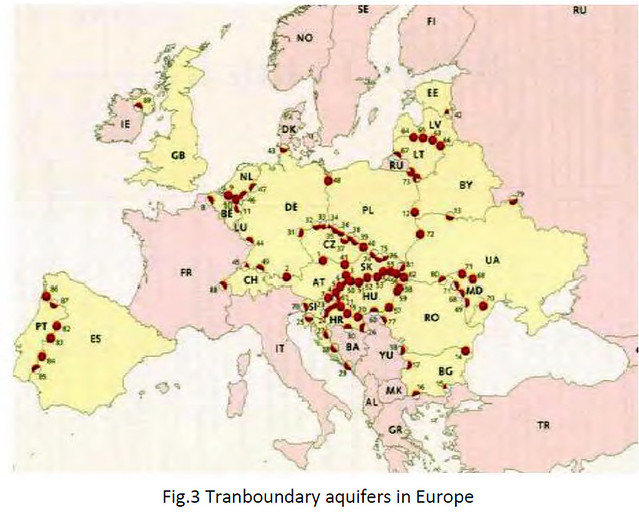 Southern Africa is one of the focal regions receiving support from ISARM in West Southern Africa. Groundwater is likely to be the key resource to improve the water supply coverage of many areas. This is important for the industrial, agricultural and societal development of the region. Groundwater is also an important conditioning factor in regional environmental processes. Boundaries of individual aquifers are mainly based on surficial extent of geological formations (lithological transitions) and surface water divides.(Fig 4)
Southern Africa is one of the focal regions receiving support from ISARM in West Southern Africa. Groundwater is likely to be the key resource to improve the water supply coverage of many areas. This is important for the industrial, agricultural and societal development of the region. Groundwater is also an important conditioning factor in regional environmental processes. Boundaries of individual aquifers are mainly based on surficial extent of geological formations (lithological transitions) and surface water divides.(Fig 4)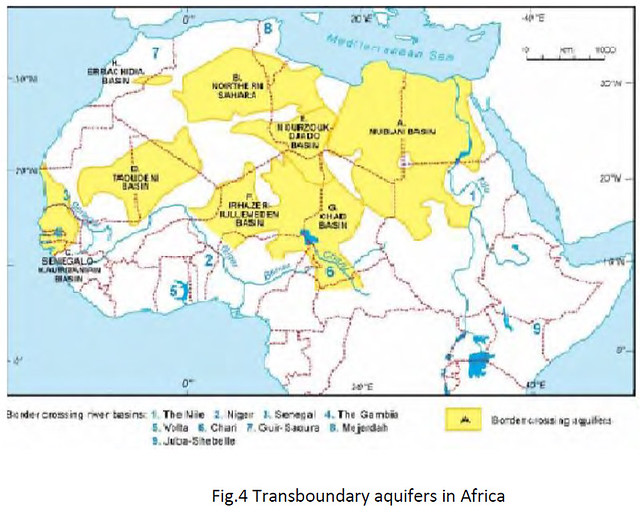 Transboundary Aquifers in Asia: There are several transboundary aquifers in Asia, involving two or more countries . UNESCO, HP has demarcated 12 transboundary aquifers which are significant and depicted in fig-5 and Table-2
Transboundary Aquifers in Asia: There are several transboundary aquifers in Asia, involving two or more countries . UNESCO, HP has demarcated 12 transboundary aquifers which are significant and depicted in fig-5 and Table-2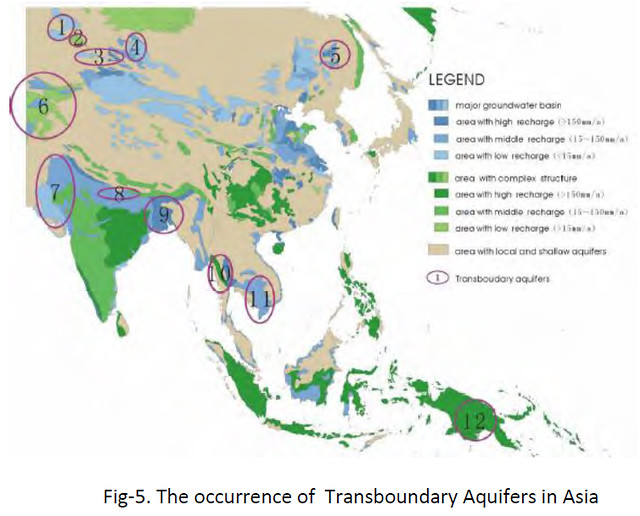
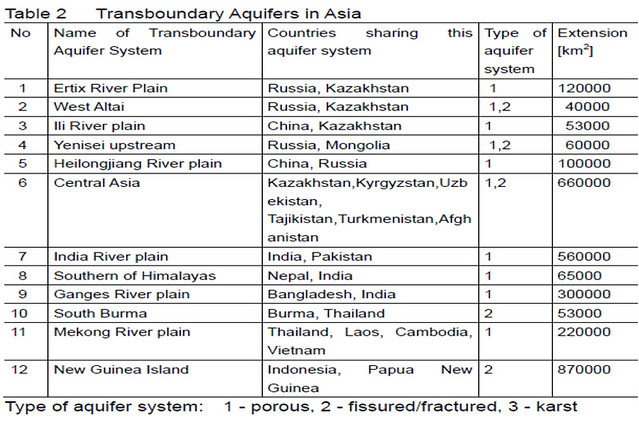 Transboundary aquifers of Indian subcontinent: Transboundary aquifers of Indian subcontinent are shared between India and neighbouring countries. There are 8 such sharing aquifers. Such Regional aquifers and their flow path crossing national boundaries some times extend over large areas. Some of the aquifers are very high yielding and can provide sustainable water supply for human need in different parts of world, including India. These aquifers are very important in view of food security in India and neighboring countries.
Transboundary aquifers of Indian subcontinent: Transboundary aquifers of Indian subcontinent are shared between India and neighbouring countries. There are 8 such sharing aquifers. Such Regional aquifers and their flow path crossing national boundaries some times extend over large areas. Some of the aquifers are very high yielding and can provide sustainable water supply for human need in different parts of world, including India. These aquifers are very important in view of food security in India and neighboring countries.REFERENCE
- Revenga C, Brunner J, Henniger N, Kassem K, Payne R(2000) Pilot analysis of Global Ecosystems: Freshwater Systems. Washington, DC: World Resources Institute.
- UNESCO/ISARM (2001) A framework document. Paris, UNISCO, non serial document on Hydrology.
- WORLD Bank (1987) Water Resources Management in South Eastern Europe, Volume-I, Issues and Directions.
- Puri S and Aureli A (2005) Transboundry aquifers: A global programme to assess, evaluate and develop policy. Groundwater, v 43(5), p.661-668
Subrata Kunar
Member(SAM), Central Ground Water Board, Faridabad
S. Shekhar
Scientist - B, Central Ground Water Board, Faridabad
A. Mukherjee
Asstt. Hydrogeologist, Central Ground Water Board, Faridabad
Path Alias
/articles/international-practices-transboundary-aquifers-resource-management
Post By: Hindi